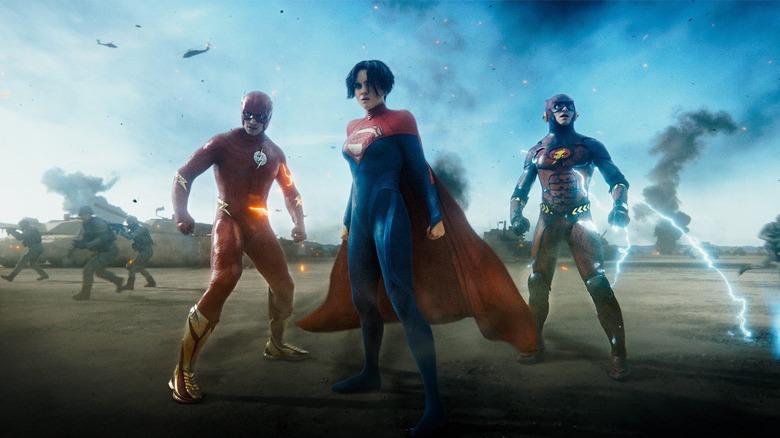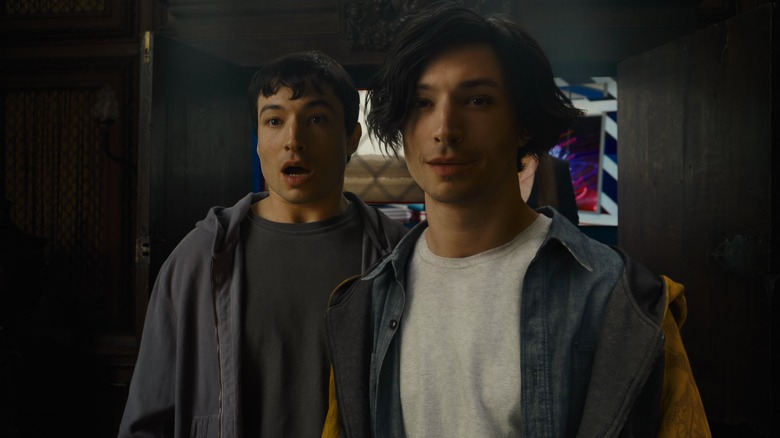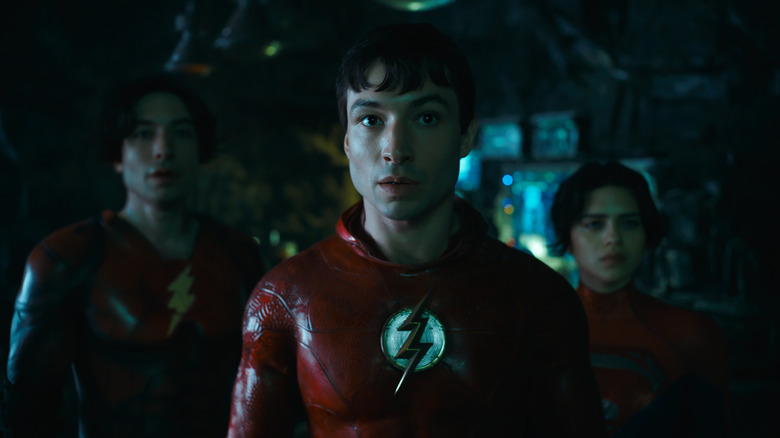The Flash Brings One Of The Character's Coolest Superpowers To Life
Warning: This article contains spoilers for "The Flash."
After arriving fully-formed into the DC Universe with that cameo in Zack Snyder's "Batman v Superman: Dawn of Justice," Ezra Miller's Barry Allen takes a long, winding, time-traveling trip back to his origins in "The Flash." Every comic book fan knows the basics of how the Scarlet Speedster first received his powers, involving the (un)lucky combination of a little lightning and getting drenched by some industrial chemicals at S.T.A.R. Labs. Though it took until his long-delayed solo movie for audiences to finally see this event for themselves (to be fair, this was covered rather comprehensively in CW's "The Flash" series), the wait proved to be worth it as director Andy Muschietti and writer Christina Hodson had some tricks up their sleeve.
To date, we've only seen the Flash show off his most traditional skills on the big screen, but that finally changes here. Obviously there's his super-speed, though "Zack Snyder's Justice League" did go a step further and introduce the concept of the Speed Force that goes on to play such an integral role in "The Flash." That's not the only power that Barry has in his repertoire, however. Early on in the film, our bumbling hero displays a never-before-seen ability that DC fans have been waiting to see depicted in the movies. And in classic Barry style, he doesn't show it off in the middle of some big action sequence while he's trying to save the day. Instead, we first witness the concept of "phasing" through solid objects in action when he needs to make a quick beer run. What else!
Thankfully, the film finds plenty of use for this power set throughout the story. And, honestly, it's pretty cool. Here's everything you need to know about the Flash's phasing powers.
Good vibrations
Would it truly be a "Flash" movie if it didn't involve some seriously wacky, universe-threatening mayhem? Unfortunately, that ended up ringing uncomfortably true with the real-life controversy surrounding star Ezra Miller's actions after filming was completed. But within the constraints of the script itself, Barry's efforts to travel back in time and prevent the death of his mother Nora (Maribel Verdú) and his father Henry (Ron Livingston) has unintended consequences on the entire multiverse, ultimately dumping him in the path of his younger, alternate self — one who promptly experiences his own lightning-induced origin story at the lab, but at the cost of our Barry's abilities. Thus begins a complicated and comedic dynamic that involves teaching the younger Barry how to control his newfound superpowers.
Chief among his new responsibilities is mastering the art of phasing. We first see our main universe Barry use this power when he invites his crush Iris West (Kiersey Clemons) over to his apartment and realizes he's short on drinks. Having already used his super-speed to clean things up a bit (or attempt to, at least), he resorts to phasing through the wall to head out and grab some beer. When it's time to impart his knowledge upon the younger and more inexperienced Barry, hijinks ensue when the latter's a little too eager to try it out and ends up phasing — naked — into the apartment of his downstairs neighbor. Accompanied by a nifty visual of the microscopic world, Barry explains it as vibrating the cells in his body to such an extent that he's able to neatly move through matter. Essentially, it's another riff on super-speed, but on a molecular level.
This power comes in handy when the duo has to break into S.T.A.R. Labs for their date with destiny.
Not just a phase
One of the best things that "The Flash" has going for it is the dynamic between both Barry Allens and the mix-up involving their powers, which leaves the older Barry at a severe disadvantage for much of the first half of the film and the younger Barry more or less living out the origin story film we never got to see with Ezra Miller's take on the hero. While he has to learn the hard way that running at incredibly fast speeds without a friction-defying suit can have some pretty dire side effects, it's his progression in figuring out how to use his phasing skills that ends up playing a surprisingly big role in the plot.
Phasing, after all, factors into several major set pieces. Not only is this how the two Barrys manage to break into the lab just in the nick of time for younger Barry to receive his powers in the electrical accident. After this inciting action kicks off the film in earnest, the power comes up again later on once supporting characters Supergirl (Sasha Calle) and an alternate universe version of Batman (none other than Michael Keaton, of course) join the fray. With Michael Shannon's invading General Zod hellbent on retrieving Supergirl at all costs, all-out war between humanity and the Kryptonians forces younger Barry into a fight for the first time, where he barely manages to use his phasing abilities to escape certain death at the hands of Zod. Later on in the so-called "Chrono Bowl," an ethereal reality untethered from space and time, we truly see the limits and potential of this power.
Going forward, it'll be interesting to see how (or if) this phasing ability is incorporated in future Flash stories.
"The Flash" is currently playing in theaters.


